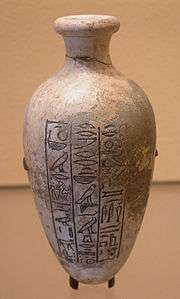Pick (hieroglyph)
| ||||||
| Pick in hieroglyphs |
|---|

Pot, with Pick hieroglyph at bottom, middle column (reads from right-to-left, Columns 3-2-1).
| Wikimedia Commons has media related to Pick (grg hieroglyph). |
The ancient Egyptian Pick hieroglyph, Gardiner sign listed nos. U17, U18 is a portrayal of a 'pick upon the side view of a block'; it is in the Gardiner subset for agriculture, crafts, and professions.
In the Egyptian language, the pick hieroglyph is used as an ideogram or determinative for grg, the verb "to pick through",[1] or for other related words.
Verb: to settle, found, establish; (also dismantle)
Though the pick hieroglyph shows: 'use of a pick, upon a surface', the verb "to choose" is not implied. The Egyptian language verb for 'to pick or select' is used by "to choose", the commonly used stp hieroglyph, an adze, or specifically the 'adze-on-block (hieroglyph)', Gardiner no. U21,
, also in the Gardiner subset of agriculture, crafts, and professions.
|
|
The pick hieroglyph in Budge's two volume dictionary has twelve entries, the final three dealing with "lies" and using the determinative of the sparrow (hieroglyph), for 'bad', 'evil', Gardiner no. G37
, (and not a swallow hieroglyph, virtually identical). The main definition of the pick hieroglyph seems to be to pick at (earth), implying use of the pick as a tool for creating a townsite, and 'constructing'; it translates as a verb, to found, establish, settle; also to make ready to be habitable, equip, furnish, and prepare.[2] Budge's dictionary sources are c. 150 authors, and c. 200 sources: papyri, steles, literature, reliefs, etc. For grg, "to settle", "to establish", etc. he uses: 1. funerary texts of Pepi I, (and 2. texts of Pepi II), 3. texts of King Teta, 4. Gaston Maspero's 1880 Recueil..., vol 1. (in progress), 5. an El-Bersheh, London document-(undated), 6. and "A. Z.", German Zeitschrift fur..., 1863, vol. 1, (a work in progress).
|
|
Example usage: 24th century BC, Palermo Stone
| ||
| Pick- (upon Townsite) (example) in hieroglyphs |
|---|
From circa 2392 BC (24th to 23rd century BC), the Palermo Piece-(obverse) of the 7—piece Palermo Stone contains two uses of the pick hieroglyph. They occur as a pair in Row III[3] (of VI rows) for a "King Year Register" for Pharaoh, King Den.
They are used above 2 rectangular blocks, with the names of cities inside, and the determinative for town:
. They are similar to the symbol for "Horus in a Chamber", Gardiner no. O10,
, but replaced by hieroglyphs that name the 2 townsites.
|
|
|
|
Preceded by
"Nightfall" grh (grḥ) |
pick grg |
Succeeded by
1. "one-half"-2. Dual 1. gs--2. gs (End of g) |
See also
References
- ↑ Betrò, 1995. Hieroglyphics: The Writings of Ancient Egypt, Pick, p. 241.
- ↑ Budge, 1978, (1920). An Egyptian Hieroglyphic Dictionary, gerg, p. 811-812.
- ↑ Schulz, Seidel, 1998. Egypt: The World of the Pharaohs, photo: Palermo Piece-(obverse), p. 24.
- Betrò, 1995. Hieroglyphics: The Writings of Ancient Egypt, Betrò, Maria Carmela, c. 1995, 1996-(English), Abbeville Press Publishers, New York, London, Paris (hardcover, ISBN 0-7892-0232-8)
- Budge, 1920, (1978). An Egyptian Hieroglyphic Dictionary, E. A. Wallis Budge, (Dover Publications), c 1978, (c 1920), Dover edition, 1978. (In two volumes, 1314 pp. and cliv-(154) pp.) (softcover, ISBN 0-486-23615-3)
- Schulz, Seidel, 1998. Egypt: The World of the Pharaohs, Editors, Regine Schulz, Matthias Seidel, Könemann Verlagsgesellschaft mbH, Cologne, English translation version, 538 pages. (hardcover, ISBN 3-89508-913-3)
This article is issued from Wikipedia - version of the Saturday, September 05, 2015. The text is available under the Creative Commons Attribution/Share Alike but additional terms may apply for the media files.